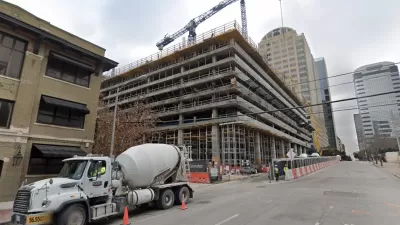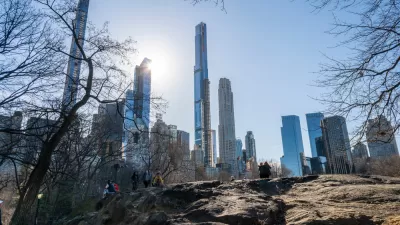Much has been made of New York's current boom in high-rise construction. A new interactive feature by the Council of Tall Buildings and Urban Habitat allows for some historic perspective on the city's penchant for building skyward.
Linda Poon shares news of a new interactive timeline from the Council of Tall Buildings and Urban Habitat (CTBUH), "which shows the rollercoaster-like progression of NYC’s skyscraper construction." The timeline also, according to Poon, "connects some of the most active and inactive years of construction with major social and political events in history."
The article concentrates especially on insights gleaned from the interative timeline into years like 1931 ("one of the most active years for building) and the 1970s. And, of course, there's perspective to be gained on the present day:
"Today, the construction of skyscrapers is once again booming, fueled largely by the rise in luxury residential construction. The clusters of blue dots—representing residential buildings—increases significantly after the 1960s. An accompanying pie chart shows that, of the 826 buildings included in the timeline, almost half are for housing."
FULL STORY: Charting the Booms and Busts of NYC's Skyscraper History

Planetizen Federal Action Tracker
A weekly monitor of how Trump’s orders and actions are impacting planners and planning in America.

Maui's Vacation Rental Debate Turns Ugly
Verbal attacks, misinformation campaigns and fistfights plague a high-stakes debate to convert thousands of vacation rentals into long-term housing.

Cuomo Is the Candidate of Both NIMBYs and Developers. What Gives?
In the New York City mayoral race, odd bedfellows align to preserve the housing status quo.

The Subversive Car-Free Guide to Trump's Great American Road Trip
Car-free ways to access Chicagoland’s best tourist attractions.

San Antonio and Austin are Fusing Into one Massive Megaregion
The region spanning the two central Texas cities is growing fast, posing challenges for local infrastructure and water supplies.

Charlottesville Temporarily Has No Zoning Code
A judge ordered the Virginia city to throw out its newly revised zoning code, leaving permitting for new development in legal limbo.
Urban Design for Planners 1: Software Tools
This six-course series explores essential urban design concepts using open source software and equips planners with the tools they need to participate fully in the urban design process.
Planning for Universal Design
Learn the tools for implementing Universal Design in planning regulations.
Heyer Gruel & Associates PA
JM Goldson LLC
Custer County Colorado
City of Camden Redevelopment Agency
City of Astoria
Transportation Research & Education Center (TREC) at Portland State University
Jefferson Parish Government
Camden Redevelopment Agency
City of Claremont





























